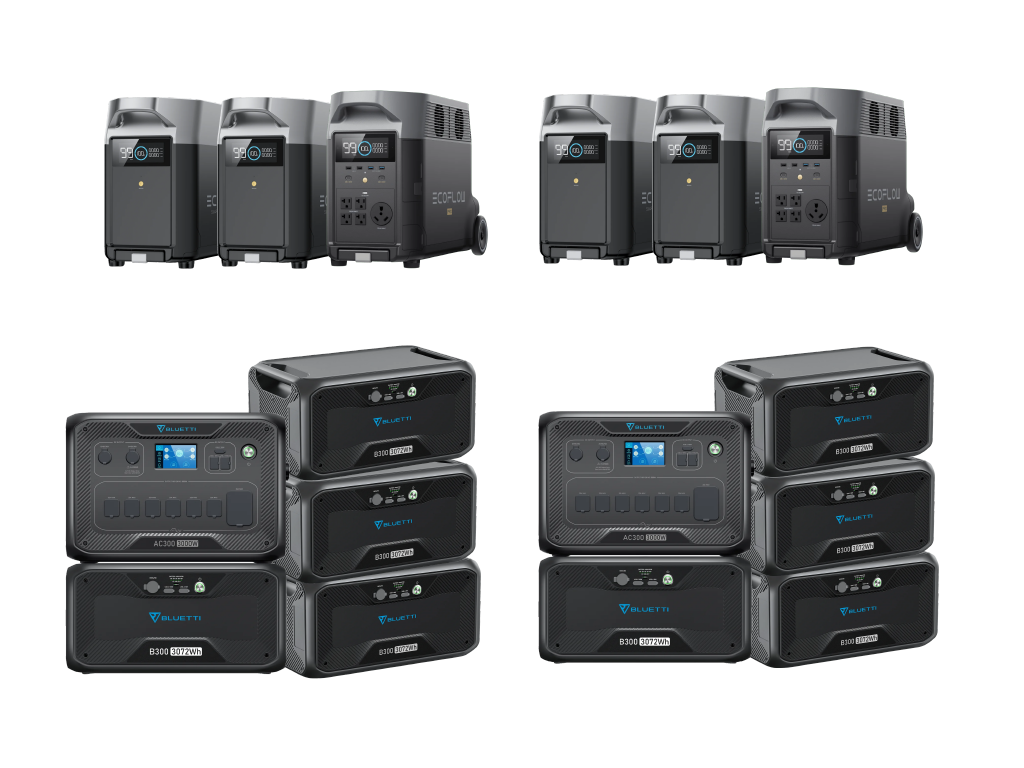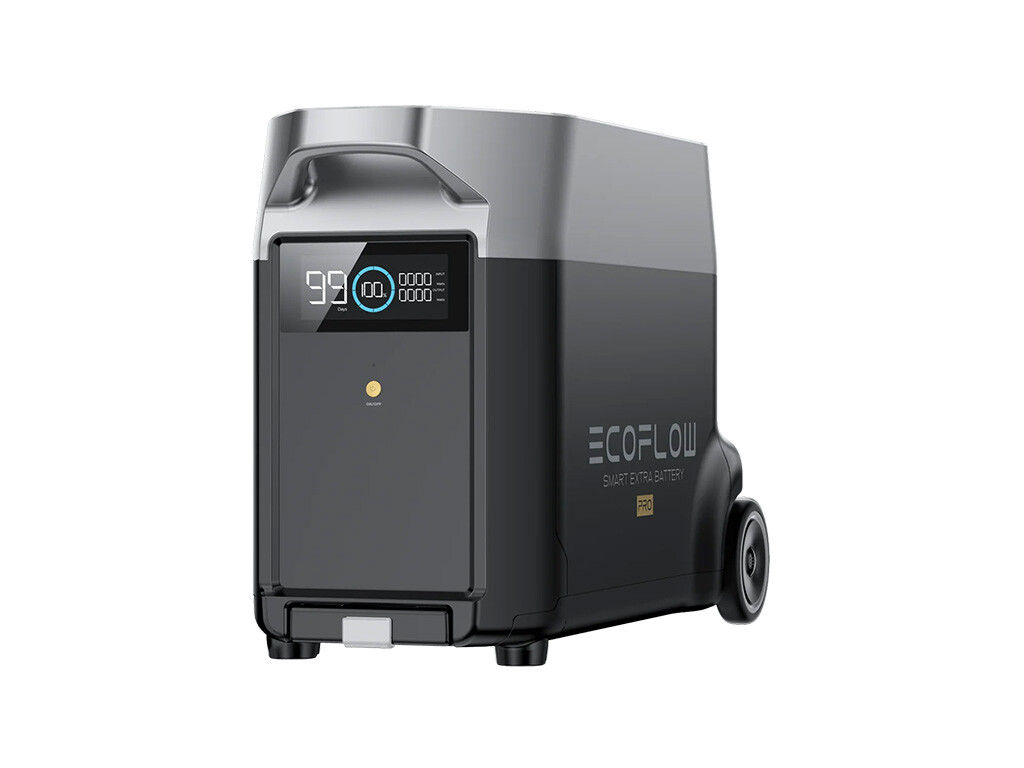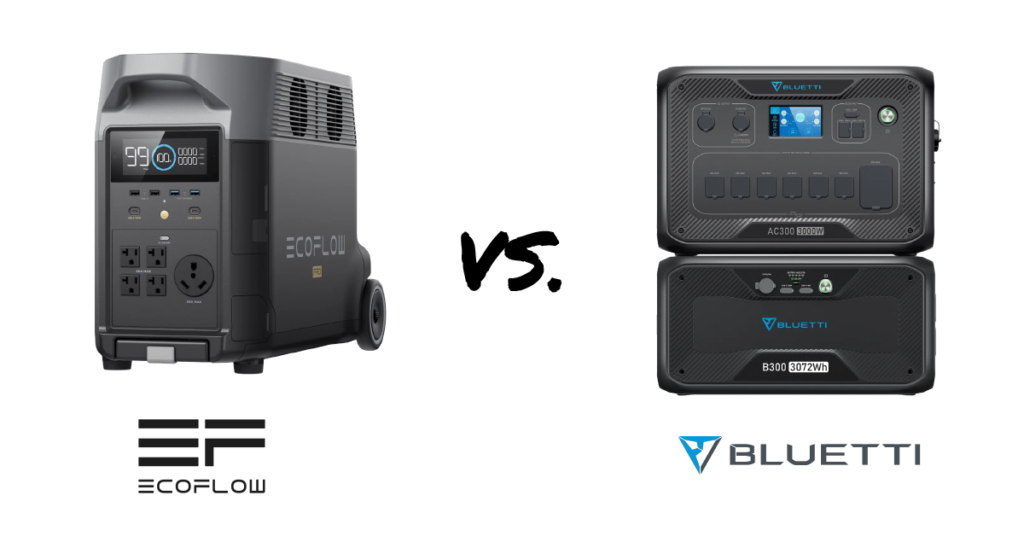Navigating the world of solar generators can be a daunting task, especially with clever marketing gimmicks, complex specifications, and mixed reviews. If you’re weighing the options between the EcoFlow Delta Pro vs. Bluetti AC300, you’ve landed in the right spot.
This article cuts through the noise to provide clear, straightforward information that will help you make the right choice. By understanding the key differences between the EcoFlow Delta Pro and Bluetti AC300, you’ll be able to make the best choice for your needs.
We carefully select the products and services we link to. If you buy through our links, we may earn a commission. There’s no extra cost to you and it helps us provide this information.

The Quick Rundown
You are looking at a very tight race between the EcoFlow Delta Pro and Bluetti AC300. These are both superb power stations with impressive capabilities. Before we go through with a fine-tooth comb, let’s take a look from high in the sky.
The ways the EcoFlow Delta Pro comes out ahead include:
- Combined battery and inverter unit
- Larger battery in each unit (by 528Wh)
- More powerful inverter (by 600W)
But the Bluetti AC300 punches back with its advantages:
- Larger maximum system battery (by 3,000Wh)
- Higher solar charging inputs (by 900W)
- Two wireless charging pads and more AC outlets
Overall, EcoFlow’s larger specifications in each unit and its combined battery/inverter design are very attractive. And the more powerful inverter size is a major advantage. This makes it a sleek unit with fewer cables and more power. For a lot of people, the EcoFlow Delta Pro is the right choice.
But the other side of the coin has a lot to offer. The Bluetti AC300’s superior solar charging input and total maximum system size are serious advantages. For those looking to either (1) use more than 1,600W solar power per inverter unit or (2) add as many batteries as possible, it’s the right choice.
In the battle of the EcoFlow Delta Pro vs. Bluetti AC300, the Delta Pro is going to come out slightly ahead for most people. The exceptions are for those who want to maximize solar input or total battery size.
Looking for alternatives? You can see the full lineup of EcoFlow products here and Bluetti products here.

|
EcoFlow DELTA Pro |
DP on EcoFlow DP on Amazon |

|
BLUETTI AC300 + B300 Home Battery Backup |
AC300 on Bluetti AC300 on Amazon |
EcoFlow Delta Pro vs. Bluetti AC300
Let’s break up the comparison of these two amazing power stations into bite-sized chunks:
- Modular Design & Battery Capacity
- AC Inverter Comparison
- Inputs and Charging Rates
- Other Features
- Final Verdict
- Full Specifications

Modular Design & Battery Capacity
The battery capacity is a very important part. It determines how long your power station can run devices. Both of these power stations are modular systems with extra battery packs, but they’re slightly different.
The EcoFlow Delta Pro system is a little more simple. Each Delta Pro includes the inverter/connections with an integrated battery pack. You can add up to 2 Extra Battery packs to each Delta Pro. And you can run 2 Delta Pro main units together. The largest system has 2 Delta Pro units and 4 battery packs.
The single-unit Delta Pro has 3,600Wh of battery capacity, 600Wh more than the single-battery AC300. Its maximum battery capacity is 21,600Wh, spread across 6 devices.
Note: You might see that EcoFlow advertises a 25kWh capacity for the Delta Pro. This includes power generated over time with the gasoline engine of the EcoFlow Smart Dual Fuel Generator. It is not the true battery capacity.
Now let’s turn to the Bluetti AC300. It has more parts and more maximum battery storage. The AC300 inverter unit does not have an internal battery, so it comes with one B300 external battery. You can add up to 4 batteries to each AC300. And you can run 2 units together. The largest system has 2 AC300 units and 8 B300 battery packs.
The smallest AC300 setup is about 528Wh less than the EcoFlow Delta Pro. And it will have two parts instead of one. But if you max out the system, you can have almost 3,000Wh more with the Bluetti AC300 than the EcoFlow Delta Pro.
They both use high-quality lithium iron phosphate (LFP or LiFePO4) battery chemistry, rated to last over 3,500 cycles while still keeping at least 80% charge.
Verdict: EcoFlow has the best single-unit power capacity, but Bluetti wins total system size.
| Feature | EcoFlow Delta Pro | Bluetti AC300 |
| Integrated battery? | Yes | No |
| Max Inverter Units | 2 | 2 |
| Max Battery Packs | 2 per unit / 4 in total | 4 per unit / 8 in total |
| Internal Battery Capacity | 3,600Wh | None |
| External Battery Capacity | 3,600Wh | 3,072Wh |
| Maximum Battery Capacity | 21,600Wh (2 units + 4 batteries) | 24,576Wh (2 units + 8 batteries) |
| Battery Chemistry | LFP / LiFePO4 | LFP / LiFePO4 |


|
EcoFlow DELTA Pro |
DP on EcoFlow DP on Amazon |

|
EcoFlow DELTA Pro Smart Extra Battery |
Buy on EcoFlow Buy on Amazon |

|
BLUETTI AC300 + B300 Home Battery Backup |
AC300 on Bluetti AC300 on Amazon |

|
BLUETTI B300 Expansion Battery |
Buy on Bluetti Buy on Amazon |

AC Inverter Comparison
The battery determines how long your power station can run devices, while the AC inverter determines the maximum power it can send at one time through the AC outlets. These power stations are both quite powerful and ready to power an entire home, especially if you use two together.
They both have a large 30-amp outlet. This is an ideal connection for RVs and home circuits. Even more important, if you use two units together in a split-phase connection (a fancy power strip), you can boost these 30-amp outlets to 240V, an even better home backup system. Both systems have nearly identical methods of performing these functions through a connection adapter and subpanel.
But once again, the EcoFlow Delta Pro comes out ahead in actual power. Its AC inverter has a 3,600W continuous power rating while the Bluetti AC300’s is 3,000W. They both can handle very short surges that are twice that continuous power.
If you’re getting close to maximizing the system, this extra 600W can make a big difference. This is mainly for people running heavy-duty appliances like air conditioners, induction stoves, or electric heaters. When you get two units, the Delta Pro’s 7.2kW is much better than the Bluetti’s 6kW.
There are other units with more powerful inverters from both of these companies, including the EcoFlow Delta Pro Ultra and the Bluetti AC500. We also recommend the Anker F3800, an excellent home backup solution.
Bluetti does win out with 6 regular 120V outlets while EcoFlow has 4. And Bluetti has two wireless charging pads on top. The EcoFlow advantage is one extra USB-C port.
Verdict: EcoFlow Delta Pro takes the undisputed win in the AC inverter category, but Bluetti has wireless charging pads.
| Feature | EcoFlow Delta Pro | Bluetti AC300 |
| AC Output | 3,600W to 7,200W (1-2 units) | 3,000W to 6,000W (1-2 units) |
| AC Outlets | 1 x 30A and 4 x 20A | 1 x 30A and 6 x 20A |
| 240V Outlet | Yes, with two units | Yes, with two units |
| USB Ports | 4 USB-A; 2 USB-C | 4 USB-A; 1 USB-C |
| Wireless Charging Pad | None | 2 x 15W |

Inputs and Charging Rates
When we turn to the power coming into the device, the EcoFlow Delta Pro vs. Bluetti AC300 battle stays hot.
First, let’s talk about AC charging. Although both companies have marketing that might make you think otherwise, the actual specifications for the EcoFlow Delta Pro and the Bluetti AC300 charging rate from a standard 120V outlet are the same at 1,800W. This means that you can plan on charging a little less than 1,800Wh per hour of charging on an AC outlet.
This is a pretty good charging rate for a single unit. You’re getting to a full charge in less than 3 hours with either option. They both also have 240V charging, but they require special equipment. Bluetti must have a special subpanel. EcoFlow only needs an adapter. The EcoFlow model can also charge at 3,400W using high-voltage EV charging stations with the right adapter. If you have access to this, you can fill the entire battery in just over 1 hour.
Now let’s switch to solar charging. Here, the Bluetti crushes the EcoFlow with 2,400W compared to 1,600W. But you do have to use two separate ports. So you must have two separate strings of panels.
Also, the Bluetti extra batteries have their own charging inputs. This can add another 500W per battery on AC power and 200W per battery from solar. This is a nice feature to have for those adding as many extra batteries as possible. You can also add on more solar or charge your batteries separately.
Bluetti offers much more solar input, both on the main unit and the battery packs. The only catch is that they aren’t through the same connection. The single-connection maximum is nearly identical, at 1,600W for EcoFlow and 1,800W for Bluetti.
Verdict: Bluetti comes out ahead with superior solar charging inputs and battery chargers, but EcoFlow’s EV fast-charging ability is great for those who might use it.
| Feature | EcoFlow Delta Pro | Bluetti AC300 |
| AC Charging Rate | 1,800W @ 120V 3,000W @ 240V 3,400W @ EV Charger | 1,800W @ 120V 3,000W @ 240V 500W (battery input) |
| Solar Charging Rate | 1,600W No solar input on battery | 2,400W (2 x 1800W ports) 200W (battery input) |

Other Features
Rounding out this comparison of the EcoFlow Delta Pro vs. Bluetti AC300 are the app connections, warranty coverage, and physical design of these solar generators.
Both companies offer an app to control and monitor your device. They both use a WiFi or Bluetooth connection, whichever you prefer. Bluetooth is great if you’re nearby and away from a WiFi network, but WiFi can connect from anywhere. Monitor your home backup system while you’re at the office or out of town.
Apps aren’t created the same. And there’s no doubting EcoFlow’s superiority here. It has been able to keep its customers much happier, while the Bluetti app suffers from connection problems and lacks functions, especially on iOS. Both can get the job done, but EcoFlow is the smooth experience we all want.
EcoFlow also comes out ahead with a total of 5 years of warranty coverage (2-year standard warranty plus another 3 years when bought from EcoFlow and registered). Bluetti AC300 warranty is 4 years, still a respectable figure.
The reputation of EcoFlow is also a little better. It’s been called the Apple of the solar generator world. It creates flawless products, all around, and stands behind them. Bluetti is also known as a high-quality power station manufacturer, but the EcoFlow fanbase is more intense.
The weight is a bit of a toss-up. EcoFlow has a heavier inverter main unit and it may be a problem for some people since it is about 100 lbs (45 kg). But that’s because it includes the battery. The AC300 alone is lighter, but when compared with the B300 battery, that combo is heavier than a single EcoFlow Delta Pro. You also don’t need as many EcoFlow Extra Batteries to max out the system.
The dimensions are fairly similar. EcoFlow is more upright and designed to be lined up side-by-side, while the Bluetti system is better for stacking. Both can work well, depending on your available space.
Verdict: With a superior app and integrated single-unit design, EcoFlow comes out ahead.
| Feature | EcoFlow Delta Pro | Bluetti AC300 |
| App Connection | Yes, WiFi & Bluetooth | Yes, WiFi & Bluetooth |
| Warranty | 2-year + 3-year (when registered) | 4-year |
| Weight | 99 lbs / 45 kg (unit with internal battery) 84 lbs / 38 kg (extra battery) | 47.6 lbs / 21.6 kg (unit w/o battery) 79.6 lbs / 36.1 kg (battery) |
| Dimensions | Unit with internal battery 25 x 11.2 x 16.4 in (63.5 x 28.4 x 42 cm) Extra battery 25 x 11.2 x 16.4 in (63.5 x 28.5 x 41.6 cm) | Unit (without battery) 20.5 x 12.5 x 14.1 in (52 x 32 x 35.8 cm) Battery 20.5 x 12.5 x 10.5 in (52 x 32 x 26.6 cm) |

Final Verdict
Even after this in-depth analysis of these power stations, it remains a difficult choice. The Bluetti has a larger maximum battery size and more solar charging input. And it comes out ahead with a couple more AC outlets and wireless charging pads.
But EcoFlow Delta Pro hits it big in most other categories. It has more battery capacity in each unit, a more powerful AC inverter, and robust charging options including an innovative EV charging ability. It also comes from a company with a slightly better reputation, especially for its app design and warranty coverage.
Although this is a very tight call, the EcoFlow Delta Pro is our top pick in this head-to-head comparison.

|
EcoFlow DELTA Pro |
DP on EcoFlow DP on Amazon |

|
BLUETTI AC300 + B300 Home Battery Backup |
AC300 on Bluetti AC300 on Amazon |
Full Specifications and User Manuals
Here’s a summary of all the specifications that matter most for these two solar generators.
| Feature | EcoFlow Delta Pro | Bluetti AC300 |
| Internal Battery Capacity | 3,600Wh | None |
| External Battery Capacity | 3,600Wh | 3,072Wh |
| Maximum Battery Capacity | 21,600Wh (2 units + 4 batteries) | 24,576Wh (2 units + 8 batteries) |
| Battery Chemistry | LFP / LiFePO4 | LFP / LiFePO4 |
| AC Output | 3,600W to 7,200W (1-2 units) | 3,000W to 6,000W (1-2 units) |
| AC Outlets | 1 x 30A and 4 x 20A | 1 x 30A and 6 x 20A |
| 240V Outlet | Yes, with two units | Yes, with two units |
| USB Ports | 4 USB-A; 2 USB-C | 4 USB-A; 1 USB-C |
| Wireless Charging Pad | None | 2 x 15W |
| AC Charging Rate | 1,800W @ 120V 3,000W @ 240V (need adapter) | 1,800W @ 120V 3,000W @ 240V (Bluetti subpanel only) |
| Solar Charging Rate | 1,600W No solar input on battery | 2,400W (2 x 1800W ports) 200W (battery input) |
| App Connection | Yes, WiFi & Bluetooth | Yes, WiFi & Bluetooth |
| Warranty | 2-year + 3-year (when registered) | 4-year |
| Weight | 99 lbs / 45 kg (unit with internal battery) 84 lbs / 38 kg (extra battery) | 47.6 lbs / 21.6 kg (unit w/o battery) 79.6 lbs / 36.1 kg (battery) |
| Dimensions | Unit with internal battery 25 x 11.2 x 16.4 in (63.5 x 28.4 x 42 cm) Extra battery 25 x 11.2 x 16.4 in (63.5 x 28.5 x 41.6 cm) | Unit (without battery) 20.5 x 12.5 x 14.1 in (52 x 32 x 35.8 cm) Battery 20.5 x 12.5 x 10.5 in (52 x 32 x 26.6 cm) |
Here are the links to the user manuals for these two devices and their batteries:
Wrap Up
As two high-quality power stations with similar specifications, the battle between EcoFlow Delta Pro vs. Bluetti AC300 couldn’t be closer. Those who want maximum solar input and total battery capacity should go with the Bluetti AC300. But due to its higher single-unit power, superior AC inverter, and impeccable reputation, the EcoFlow Delta Pro is our top pick.
Ready to order your power station and transform it into a solar generator? You can use this solar panel calculator to figure out how many panels you need.







